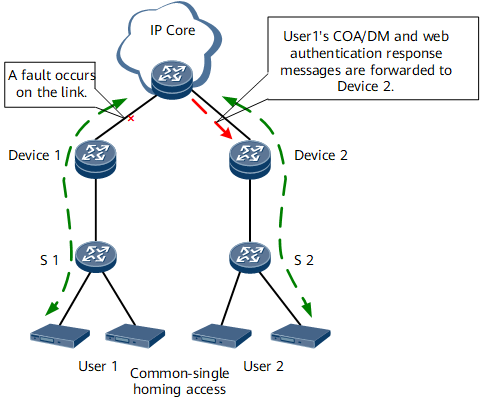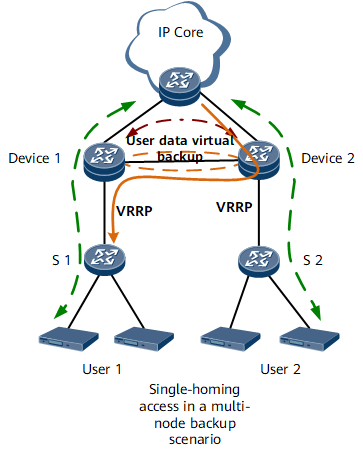Single-Homing Access in a User Access Multi-Device Backup Scenario
Dual-homing access may fail to be deployed in a multi-node backup scenario due to insufficient resources. If this problem occurs, single-homing access can be used. On the network shown in Figure 1, network traffic can be forwarded by either NetEngine 8000 F 1 or NetEngine 8000 F 2. If common single-homing access is used, NetEngine 8000 F 2 will discard User1's change-of-authorization (COA) or disconnect message (DM) and web authentication response messages upon receipt. This case causes User1's COA/DM and web authentications to fail. If the link between NetEngine 8000 F 1 and the network goes faulty, the preceding problem will also occur.
To resolve the preceding problem, configure user data virtual backup between NetEngine 8000 F 1 and NetEngine 8000 F 2. On the network shown in Figure 2, information about User1's identity is backed up on NetEngine 8000 F 2. The aggregation switch S1 is single-homed to NetEngine 8000 F 1. VRRP is deployed on the access side. One VRRP protection group is deployed for each pair of active and standby links. If the VRRP group is in the Master state, the access link can be accessed by users. If User1's COA/DM and web authentication response messages are randomly delivered to NetEngine 8000 F 2, user data virtual backup allows NetEngine 8000 F 2 to forward the response messages to NetEngine 8000 F 1. Additionally, if the link between NetEngine 8000 F 1 and the network goes faulty, NetEngine 8000 F 2 can also take over the traffic on the faulty link, preventing traffic interruption.

Single-homing access in a multi-node backup scenario can be implemented only after user data virtual backup is configured.

